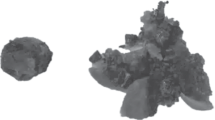Abstract
Systems for the joint electrodeposition of molybdenum (tungsten) and nickel(cobalt) from ionic melts have been identified. Conditions for depositing the intermetallics molybdenum(tungsten)-nickel(cobalt) and double carbides based on these were ascertained. It is shown that the process of electrochemical synthesis is determined, on the whole, by the ratio of partial currents of reacting components, energies of interaction between them, and the occurrence of parallel reactions between components.
Similar content being viewed by others
References
A. T. Vas'ko and S. K. Kovach, Electrochemistry of the Refractory Metals [in Russian], Naukova Dumka, Kiev (1983).
O. A. Berkh, B N. Kaznachei, and Yu. M.Polukarov, “Galvanic high-coercivity coatings for magnetic media,” Itogi Nauki i Tekhniki. Élektrokhimiya,23, 3–60 (1986).
Yu. K. Delimarskii, Polarography of Ionic Melts [in Russian], Naukova Dumka, Kiev (1978).
Yu. K. Delimarskii, V. F. Grishchenko, and N. I. Parkhomenko, “Chronopotentiometric behavior of cobalt ions in chloride melts,” Ukr. Khim. Zhurn.,41, No. 11, 1123–1126 (1975).
Kh. B. Kushkhov, V. V. Malyshev, V. I. Shapoval, and S. G. Gasviani, “The effect of fluoride and fluoraluminate ions on electroreduction of the molybdenate ion in chloride-fluoride melts,” Ibid.,57, No. 4, 375–379 (1991).
Kh. B. Kushkhov, V. I. Shapoval, V. V. Malyshev, and A. A. Tishchenko, “Effect of fluoride and fluoraluminate ions on the electroreduction of tungstate ions in chloride-fluoride melts,” Élektrokhimiya,28, No. 2, 152–157 (1992).
V. I. Shapoval, V. V. Malyshev, I. A. Novosyolova, and K. B. Kushkov, “High temperature synthesis of refractory compounds of VI-A group metals in ion melts,” Electrochem. Soc. Extended Abstracts, Vol. 1, Abst. 1056, p. 1591, San Francisco (1994).
Kh. B. Kushkhov, D. G. Supatashvili, V. I. Shapoval, et al. “Joint electroreduction of the molybdate ion with nickel and cobalt cathodes in chloride melts.” Élektrokhimiya,26, No. 3, 300–304 (1990).
Kh. B. Kushkhov, D. G. Supatashvili, and I. A. Novoselova, “Joint electroreduction of various ionic forms of with cathodes of nickel and cobalt in halide melts,” ibid., No. 6, 720–723.
Kh. B. Kushkhov, V. I. Shapoval, and I. A. Novoselova, “Electrochemical behavior of carbon dioxide gas under excess pressure in an equimolar melt of potassium and sodium chlorides.” ibid..23. No. 7. 952–956 (1987).
Additional information
Institute of General and Inorganic Chemistry, Ukrainian Academy of Sciences, Kiev. Translated from Poroshkovaya Metallurgiya, Nos. 3/4(384), pp. 1–6, March–April. 1996. Original article submitted June 20, 1994.
Rights and permissions
About this article
Cite this article
Novoselova, I.A., Malyshev, V.V., Kushkhov, K.B. et al. Electrochemical synthesis of intermetallic compounds and complex carbides based on molybdenum (tungsten) and cobalt (nickel). Powder Metall Met Ceram 35, 113–117 (1996). https://doi.org/10.1007/BF01389593
Issue Date:
DOI: https://doi.org/10.1007/BF01389593




